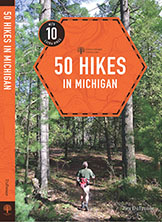We’re Not in Kansas Any More Toto
 Jim DuFresne is a lifelong Michigander and loves his home state. But his son and daughter-in-law live in Colorado and during a recent trip to the Rocky Mountain State, he tries to figure out if they will ever return to the Great Lakes State. You can read the answer in his latest Trail Talk blog for MichiganTrailMaps.com.
Jim DuFresne is a lifelong Michigander and loves his home state. But his son and daughter-in-law live in Colorado and during a recent trip to the Rocky Mountain State, he tries to figure out if they will ever return to the Great Lakes State. You can read the answer in his latest Trail Talk blog for MichiganTrailMaps.com.
Enjoy the Fourth of July weekend but be safe by heading into the woods for a hike. For ideas of where to go order a copy of Jim DuFresne’s 50 Hikes in Michigan from our eshop. The full color guidebook covers the best 60 trails in the Lower Peninsula.
By Jim DuFresne
I once asked my son why he moved to Denver, what did Colorado have that Michigan didn’t? He answered the question in one word, “mountains.” Okay, fine, but you’ll be back. And when he asked why I said “water.”

Jim DuFresne
Thirty-six hours after arriving in Denver – the Mile-High City – Michael and I were driving even higher for a hike in the Rocky Mountains. We were just short of Monarch Pass when we reached a trailhead that was already above 10,000 feet in elevation. A rocky path departed from the parking lot and immediately began to climb even higher.
I’m a flatlander, somebody who lives in a state where the highest elevation is not much above 1,900 feet, and there are only a few of those “lofty peaks” in Michigan, all located in the western U.P. With little time to get acclimatized, I struggled with the thin air and found myself stopping to suck in as much of it as I could through my mouth.
My next hike two days later was at Rocky Mountain Arsenal National Wildlife Refuge, located 8 miles northwest of downtown Denver. The preserve is a bit of misnomer. Slowly being encircled by the sprawl of Colorado’s largest urban area, the refuge neither stores weapons nor has anything to do with the Rocky Mountains.

Michael and Melissa DuFresne backpacking in the mountains of Colorado.
The 15,988-acre tract is the former Rocky Mountain Arsenal, a chemical weapons manufacturing facility that traces its beginnings to the Dec. 7, 1941, attack on Pearl Harbor. It was built the following year and was operated by the U.S. Army until 1985. Two years later, environmental testing revealed that the site was extremely polluted.
But during the extensive testing and clean up that followed workers discovered a winter roost of bald eagles, then an endangered species, in the middle of the formal arsenal. Additional studies revealed that the RMA was home to more than 330 species of wildlife. People couldn’t live there but somehow wildlife managed to so in 1992 the area was turned into a national wildlife refuge.
I was there because the refuge is basically this flat area of predominately shrubland and shortgrass prairie laced by more than 10 miles of trails. Thin air wasn’t a problem. Heat was. It was already in the mid-90s when my wife and I arrived at 11 a.m.
In Denver, they love to tell you that it’s a “dry heat” so it really isn’t 90 degrees. A transplant I met in the trailhead parking lot said, humid or dry “94 degrees is still 94 degrees.” The only difference he added is your shirt won’t be drenched when you finish your hike.

Hiking at the Rocky Mountain Arsenal National Wildlife Refuge.
In the center of the refuge is a series of man-made lakes and ponds that were connected by trails and floating boardwalks. Peg and I hiked several miles of them, and while we didn’t see any bald eagles, we saw numerous egrets, including eight at once in the south end of Lake Ladora.
After a couple of hours out in the blazing sun, that non-90-degree weather had drained us. That’s why the main attraction of the refuge was so appealing. We hopped in our car, turned the air conditioning on full blast and drove the 11-mile Wildlife Drive at about 15 mph. Refuge rules forbid you from leaving your car during the drive, which was fine with us.
The Rocky Mountain Arsenal Wildlife Drive is similar to the one at Seney National Wildlife Refuge in the Upper Peninsula, only instead of wetlands, pools and forests of large pines, there were prairies, scattered cottonwoods and a sluggish stream. But the amount of wildlife we saw – in the middle of a 90-degree day on the edge of Denver – stunned me.
Arrive at dawn or dusk, the prime times for wildlife watching, and it’s possible to see burrowing owls, coyotes, black-footed ferrets, raptors and even white pelicans. We saw at least a dozen mule deer, one sitting in the shade of a cottonwood with a rack so large I thought it was an elk at first. And a herd of 70 to 80 buffalo with two dozen of them being just borne calves. The bison herd is the result of 16 that were transferred from the National Bison Range in Montana in 2007.

Mule deer in the Rocky Mountain Arsenal National Wildlife Refuge.
But the high point of the afternoon was passing through the middle of a large colony of black-tailed prairie dogs who stood on the edge of their holes and watched us as curiously as we did them. I realized that these “rodents” are not the most beloved creatures of most Coloradans, especially ranchers. But I’m a flatlander from the Midwest who thought the encounter with hundreds of prairie dogs was the most amazing – and comical – part of the drive.
Near the end, the one-way loop takes a sharp left, and for the next couple of miles, we were heading west through a wide expanse of prairie towards the towering, snow-covered Rocky Mountains that dominated the horizon. It was a stunning contrast, one that 150 years ago probably made every pioneer driving a covered wagon to the promised land that was California to pause and reflect. It did to me last week.
This wasn’t Michigan. Not even close. I don’t think my son is coming back any time soon.
For more on visiting the Rocky Mountain Arsenal National Wildlife Refuge go to the refuge’s website.


